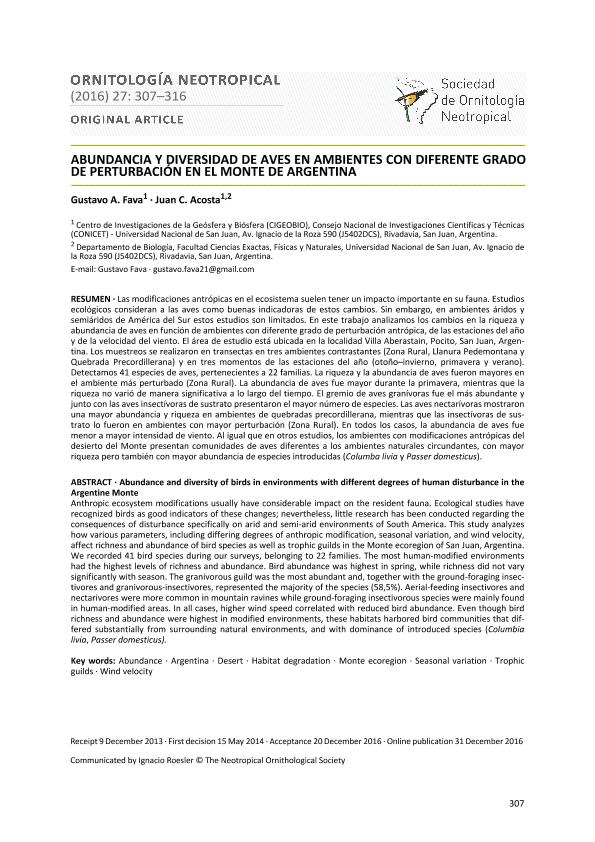Artículo
Las modificaciones antrópicas en el ecosistema suelen tener un impacto importante en su fauna. Estudios ecológicos consideran a las aves como buenas indicadoras de estos cambios. Sin embargo, en ambientes áridos y semiáridos de América del Sur estos estudios son limitados. En este trabajo analizamos los cambios en la riqueza y abundancia de aves en función de ambientes con diferente grado de perturbación antrópica, de las estaciones del año y de la velocidad del viento. El área de estudio está ubicada en la localidad Villa Aberastain, Pocito, San Juan, Argen‐ tina. Los muestreos se realizaron en transectas en tres ambientes contrastantes (Zona Rural, Llanura Pedemontana y Quebrada Precordillerana) y en tres momentos de las estaciones del año (otoño–invierno, primavera y verano). Detectamos 41 especies de aves, pertenecientes a 22 familias. La riqueza y la abundancia de aves fueron mayores en el ambiente más perturbado (Zona Rural). La abundancia de aves fue mayor durante la primavera, mientras que la riqueza no varió de manera significativa a lo largo del tiempo. El gremio de aves granívoras fue el más abundante y junto con las aves insectívoras de sustrato presentaron el mayor número de especies. Las aves nectarívoras mostraron una mayor abundancia y riqueza en ambientes de quebradas precordillerana, mientras que las insectívoras de sus‐ trato lo fueron en ambientes con mayor perturbación (Zona Rural). En todos los casos, la abundancia de aves fue menor a mayor intensidad de viento. Al igual que en otros estudios, los ambientes con modificaciones antrópicas del desierto del Monte presentan comunidades de aves diferentes a los ambientes naturales circundantes, con mayor riqueza pero también con mayor abundancia de especies introducidas (Columba livia y Passer domesticus). Anthropic ecosystem modifications usually have considerable impact on the resident fauna. Ecological studies have recognized birds as good indicators of these changes; nevertheless, little research has been conducted regarding the consequences of disturbance specifically on arid and semi‐arid environments of South America. This study analyzes how various parameters, including differing degrees of anthropic modification, seasonal variation, and wind velocity, affect richness and abundance of bird species as well as trophic guilds in the Monte ecoregion of San Juan, Argentina. We recorded 41 bird species during our surveys, belonging to 22 families. The most human‐modified environments had the highest levels of richness and abundance. Bird abundance was highest in spring, while richness did not vary significantly with season. The granivorous guild was the most abundant and, together with the ground‐foraging insec‐ tivores and granivorous‐insectivores, represented the majority of the species (58,5%). Aerial‐feeding insectivores and nectarivores were more common in mountain ravines while ground‐foraging insectivorous species were mainly found in human‐modified areas. In all cases, higher wind speed correlated with reduced bird abundance. Even though bird richness and abundance were highest in modified environments, these habitats harbored bird communities that dif‐ fered substantially from surrounding natural environments, and with dominance of introduced species (Columbia livia, Passer domesticus).
Abundancia y diversidad de aves en ambientes con diferente grado de perturbación en el Monte de Argentina
Título:
Abundance and diversity of birds in environments with different degrees of human disturbance in the Argentine Monte
Fecha de publicación:
10/2016
Editorial:
Neotropical Ornithological Society
Revista:
Ornitología Neotropical
ISSN:
1075-4377
Idioma:
Español
Tipo de recurso:
Artículo publicado
Clasificación temática:
Resumen
Palabras clave:
Abundance
,
Argentina Desert
,
Habitat degradation
,
Seasonal variation
Archivos asociados
Licencia
Identificadores
Colecciones
Articulos(CIGEOBIO)
Articulos de CENTRO DE INVESTIGACIONES DE LA GEOSFERA Y BIOSFERA
Articulos de CENTRO DE INVESTIGACIONES DE LA GEOSFERA Y BIOSFERA
Citación
Fava, Gustavo Alfredo; Acosta, Juan Carlos; Abundancia y diversidad de aves en ambientes con diferente grado de perturbación en el Monte de Argentina; Neotropical Ornithological Society; Ornitología Neotropical; 27; 10-2016; 307-316
Compartir




